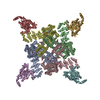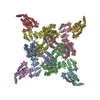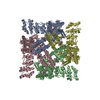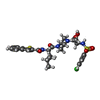[English] 日本語
 Yorodumi
Yorodumi- EMDB-28976: Cryo-EM structure of the human TRPV4 in complex with GSK1016790A -
+ Open data
Open data
- Basic information
Basic information
| Entry |  | |||||||||
|---|---|---|---|---|---|---|---|---|---|---|
| Title | Cryo-EM structure of the human TRPV4 in complex with GSK1016790A | |||||||||
 Map data Map data | main_map | |||||||||
 Sample Sample |
| |||||||||
 Keywords Keywords | TRPV4 / RhoA / GSK1016790A / MEMBRANE PROTEIN | |||||||||
| Function / homology |  Function and homology information Function and homology informationblood vessel endothelial cell delamination / osmosensor activity / vasopressin secretion / stretch-activated, monoatomic cation-selective, calcium channel activity / positive regulation of striated muscle contraction / calcium ion import into cytosol / positive regulation of macrophage inflammatory protein 1 alpha production / negative regulation of brown fat cell differentiation / positive regulation of microtubule depolymerization / hyperosmotic salinity response ...blood vessel endothelial cell delamination / osmosensor activity / vasopressin secretion / stretch-activated, monoatomic cation-selective, calcium channel activity / positive regulation of striated muscle contraction / calcium ion import into cytosol / positive regulation of macrophage inflammatory protein 1 alpha production / negative regulation of brown fat cell differentiation / positive regulation of microtubule depolymerization / hyperosmotic salinity response / cortical microtubule organization / regulation of response to osmotic stress / positive regulation of chemokine (C-X-C motif) ligand 1 production / positive regulation of chemokine (C-C motif) ligand 5 production / cartilage development involved in endochondral bone morphogenesis / aortic valve formation / alpha-beta T cell lineage commitment / mitotic cleavage furrow formation / bone trabecula morphogenesis / positive regulation of lipase activity / endothelial tube lumen extension / skeletal muscle satellite cell migration / positive regulation of vascular associated smooth muscle contraction / angiotensin-mediated vasoconstriction involved in regulation of systemic arterial blood pressure / SLIT2:ROBO1 increases RHOA activity / RHO GTPases Activate Rhotekin and Rhophilins / Roundabout signaling pathway / cellular hypotonic response / negative regulation of intracellular steroid hormone receptor signaling pathway / Axonal growth inhibition (RHOA activation) / Axonal growth stimulation / cellular hypotonic salinity response / regulation of neural precursor cell proliferation / cleavage furrow formation / regulation of modification of postsynaptic actin cytoskeleton / multicellular organismal-level water homeostasis / regulation of osteoblast proliferation / forebrain radial glial cell differentiation / cell junction assembly / apical junction assembly / regulation of systemic arterial blood pressure by endothelin / cellular response to chemokine / positive regulation of vascular permeability / negative regulation of cell migration involved in sprouting angiogenesis / negative regulation of cell size / beta selection / establishment of epithelial cell apical/basal polarity / regulation of modification of postsynaptic structure / RHO GTPases Activate ROCKs / negative regulation of oxidative phosphorylation / negative regulation of motor neuron apoptotic process / cellular response to osmotic stress / calcium ion import / osmosensory signaling pathway / cell volume homeostasis / RHO GTPases activate CIT / positive regulation of monocyte chemotactic protein-1 production / Sema4D induced cell migration and growth-cone collapse / PCP/CE pathway / RHO GTPases activate KTN1 / apolipoprotein A-I-mediated signaling pathway / positive regulation of podosome assembly / cell-cell junction assembly / negative regulation of cell-substrate adhesion / TRP channels / positive regulation of alpha-beta T cell differentiation / ossification involved in bone maturation / odontogenesis / Wnt signaling pathway, planar cell polarity pathway / Sema4D mediated inhibition of cell attachment and migration / motor neuron apoptotic process / positive regulation of leukocyte adhesion to vascular endothelial cell / PI3K/AKT activation / wound healing, spreading of cells / apical junction complex / regulation of neuron projection development / regulation of focal adhesion assembly / negative chemotaxis / regulation of aerobic respiration / cortical actin cytoskeleton / myosin binding / positive regulation of macrophage chemotaxis / EPHA-mediated growth cone collapse / stress fiber assembly / beta-tubulin binding / RHOC GTPase cycle / diet induced thermogenesis / androgen receptor signaling pathway / positive regulation of cytokinesis / cerebral cortex cell migration / microtubule polymerization / cellular response to cytokine stimulus / cytoplasmic microtubule / ERBB2 Regulates Cell Motility / cleavage furrow / semaphorin-plexin signaling pathway / Rho protein signal transduction / ficolin-1-rich granule membrane / mitotic spindle assembly / alpha-tubulin binding Similarity search - Function | |||||||||
| Biological species |  Homo sapiens (human) Homo sapiens (human) | |||||||||
| Method | single particle reconstruction / cryo EM / Resolution: 3.47 Å | |||||||||
 Authors Authors | Kwon DH / Lee S-Y / Zhang F | |||||||||
| Funding support | 1 items
| |||||||||
 Citation Citation |  Journal: Nat Commun / Year: 2023 Journal: Nat Commun / Year: 2023Title: TRPV4-Rho GTPase complex structures reveal mechanisms of gating and disease. Authors: Do Hoon Kwon / Feng Zhang / Brett A McCray / Shasha Feng / Meha Kumar / Jeremy M Sullivan / Wonpil Im / Charlotte J Sumner / Seok-Yong Lee /  Abstract: Crosstalk between ion channels and small GTPases is critical during homeostasis and disease, but little is known about the structural underpinnings of these interactions. TRPV4 is a polymodal, ...Crosstalk between ion channels and small GTPases is critical during homeostasis and disease, but little is known about the structural underpinnings of these interactions. TRPV4 is a polymodal, calcium-permeable cation channel that has emerged as a potential therapeutic target in multiple conditions. Gain-of-function mutations also cause hereditary neuromuscular disease. Here, we present cryo-EM structures of human TRPV4 in complex with RhoA in the ligand-free, antagonist-bound closed, and agonist-bound open states. These structures reveal the mechanism of ligand-dependent TRPV4 gating. Channel activation is associated with rigid-body rotation of the intracellular ankyrin repeat domain, but state-dependent interaction with membrane-anchored RhoA constrains this movement. Notably, many residues at the TRPV4-RhoA interface are mutated in disease and perturbing this interface by introducing mutations into either TRPV4 or RhoA increases TRPV4 channel activity. Together, these results suggest that RhoA serves as an auxiliary subunit for TRPV4, regulating TRPV4-mediated calcium homeostasis and disruption of TRPV4-RhoA interactions can lead to TRPV4-related neuromuscular disease. These insights will help facilitate TRPV4 therapeutics development. | |||||||||
| History |
|
- Structure visualization
Structure visualization
| Supplemental images |
|---|
- Downloads & links
Downloads & links
-EMDB archive
| Map data |  emd_28976.map.gz emd_28976.map.gz | 59.7 MB |  EMDB map data format EMDB map data format | |
|---|---|---|---|---|
| Header (meta data) |  emd-28976-v30.xml emd-28976-v30.xml emd-28976.xml emd-28976.xml | 16.2 KB 16.2 KB | Display Display |  EMDB header EMDB header |
| Images |  emd_28976.png emd_28976.png | 80.7 KB | ||
| Filedesc metadata |  emd-28976.cif.gz emd-28976.cif.gz | 6.1 KB | ||
| Others |  emd_28976_half_map_1.map.gz emd_28976_half_map_1.map.gz emd_28976_half_map_2.map.gz emd_28976_half_map_2.map.gz | 58.9 MB 58.9 MB | ||
| Archive directory |  http://ftp.pdbj.org/pub/emdb/structures/EMD-28976 http://ftp.pdbj.org/pub/emdb/structures/EMD-28976 ftp://ftp.pdbj.org/pub/emdb/structures/EMD-28976 ftp://ftp.pdbj.org/pub/emdb/structures/EMD-28976 | HTTPS FTP |
-Validation report
| Summary document |  emd_28976_validation.pdf.gz emd_28976_validation.pdf.gz | 805.7 KB | Display |  EMDB validaton report EMDB validaton report |
|---|---|---|---|---|
| Full document |  emd_28976_full_validation.pdf.gz emd_28976_full_validation.pdf.gz | 805.3 KB | Display | |
| Data in XML |  emd_28976_validation.xml.gz emd_28976_validation.xml.gz | 12.1 KB | Display | |
| Data in CIF |  emd_28976_validation.cif.gz emd_28976_validation.cif.gz | 14.2 KB | Display | |
| Arichive directory |  https://ftp.pdbj.org/pub/emdb/validation_reports/EMD-28976 https://ftp.pdbj.org/pub/emdb/validation_reports/EMD-28976 ftp://ftp.pdbj.org/pub/emdb/validation_reports/EMD-28976 ftp://ftp.pdbj.org/pub/emdb/validation_reports/EMD-28976 | HTTPS FTP |
-Related structure data
| Related structure data |  8fc8MC  8fcbMC  8fc7C  8fc9C  8fcaC C: citing same article ( M: atomic model generated by this map |
|---|---|
| Similar structure data | Similarity search - Function & homology  F&H Search F&H Search |
- Links
Links
| EMDB pages |  EMDB (EBI/PDBe) / EMDB (EBI/PDBe) /  EMDataResource EMDataResource |
|---|---|
| Related items in Molecule of the Month |
- Map
Map
| File |  Download / File: emd_28976.map.gz / Format: CCP4 / Size: 64 MB / Type: IMAGE STORED AS FLOATING POINT NUMBER (4 BYTES) Download / File: emd_28976.map.gz / Format: CCP4 / Size: 64 MB / Type: IMAGE STORED AS FLOATING POINT NUMBER (4 BYTES) | ||||||||||||||||||||
|---|---|---|---|---|---|---|---|---|---|---|---|---|---|---|---|---|---|---|---|---|---|
| Annotation | main_map | ||||||||||||||||||||
| Voxel size | X=Y=Z: 1.08 Å | ||||||||||||||||||||
| Density |
| ||||||||||||||||||||
| Symmetry | Space group: 1 | ||||||||||||||||||||
| Details | EMDB XML:
|
-Supplemental data
-Half map: Half A
| File | emd_28976_half_map_1.map | ||||||||||||
|---|---|---|---|---|---|---|---|---|---|---|---|---|---|
| Annotation | Half_A | ||||||||||||
| Projections & Slices |
| ||||||||||||
| Density Histograms |
-Half map: Half B
| File | emd_28976_half_map_2.map | ||||||||||||
|---|---|---|---|---|---|---|---|---|---|---|---|---|---|
| Annotation | Half_B | ||||||||||||
| Projections & Slices |
| ||||||||||||
| Density Histograms |
- Sample components
Sample components
-Entire : The complex of human TRPV4 with RhoA
| Entire | Name: The complex of human TRPV4 with RhoA |
|---|---|
| Components |
|
-Supramolecule #1: The complex of human TRPV4 with RhoA
| Supramolecule | Name: The complex of human TRPV4 with RhoA / type: complex / ID: 1 / Parent: 0 / Macromolecule list: #1 |
|---|---|
| Source (natural) | Organism:  Homo sapiens (human) Homo sapiens (human) |
| Molecular weight | Theoretical: 450 KDa |
-Macromolecule #1: Transient receptor potential cation channel subfamily V member 4
| Macromolecule | Name: Transient receptor potential cation channel subfamily V member 4 type: protein_or_peptide / ID: 1 / Number of copies: 4 / Enantiomer: LEVO |
|---|---|
| Source (natural) | Organism:  Homo sapiens (human) Homo sapiens (human) |
| Molecular weight | Theoretical: 102.057797 KDa |
| Recombinant expression | Organism:  Homo sapiens (human) Homo sapiens (human) |
| Sequence | String: MADSSEGPRA GPGEVAELPG DESGTPGGEA FPLSSLANLF EGEDGSLSPS PADASRPAGP GDGRPNLRMK FQGAFRKGVP NPIDLLEST LYESSVVPGP KKAPMDSLFD YGTYRHHSSD NKRWRKKIIE KQPQSPKAPA PQPPPILKVF NRPILFDIVS R GSTADLDG ...String: MADSSEGPRA GPGEVAELPG DESGTPGGEA FPLSSLANLF EGEDGSLSPS PADASRPAGP GDGRPNLRMK FQGAFRKGVP NPIDLLEST LYESSVVPGP KKAPMDSLFD YGTYRHHSSD NKRWRKKIIE KQPQSPKAPA PQPPPILKVF NRPILFDIVS R GSTADLDG LLPFLLTHKK RLTDEEFREP STGKTCLPKA LLNLSNGRND TIPVLLDIAE RTGNMREFIN SPFRDIYYRG QT ALHIAIE RRCKHYVELL VAQGADVHAQ ARGRFFQPKD EGGYFYFGEL PLSLAACTNQ PHIVNYLTEN PHKKADMRRQ DSR GNTVLH ALVAIADNTR ENTKFVTKMY DLLLLKCARL FPDSNLEAVL NNDGLSPLMM AAKTGKIGIF QHIIRREVTD EDTR HLSRK FKDWAYGPVY SSLYDLSSLD TCGEEASVLE ILVYNSKIEN RHEMLAVEPI NELLRDKWRK FGAVSFYINV VSYLC AMVI FTLTAYYQPL EGTPPYPYRT TVDYLRLAGE VITLFTGVLF FFTNIKDLFM KKCPGVNSLF IDGSFQLLYF IYSVLV IVS AALYLAGIEA YLAVMVFALV LGWMNALYFT RGLKLTGTYS IMIQKILFKD LFRFLLVYLL FMIGYASALV SLLNPCA NM KVCNEDQTNC TVPTYPSCRD SETFSTFLLD LFKLTIGMGD LEMLSSTKYP VVFIILLVTY IILTFVLLLN MLIALMGE T VGQVSKESKH IWKLQWATTI LDIERSFPVF LRKAFRSGEM VTVGKSSDGT PDRRWCFRVD EVNWSHWNQN LGIINEDPG KNETYQYYGF SHTVGRLRRD RWSSVVPRVV ELNKNSNPDE VVVPLDSMGN PRCDGHQQGY PRKWRTDDAP LENSLEVLFQ GPDYKDDDD KAHHHHHHHH HH UniProtKB: Transient receptor potential cation channel subfamily V member 4 |
-Macromolecule #2: N-[(2S)-1-{4-[N-(2,4-dichlorobenzene-1-sulfonyl)-L-seryl]piperazi...
| Macromolecule | Name: N-[(2S)-1-{4-[N-(2,4-dichlorobenzene-1-sulfonyl)-L-seryl]piperazin-1-yl}-4-methyl-1-oxopentan-2-yl]-1-benzothiophene-2-carboxamide type: ligand / ID: 2 / Number of copies: 4 / Formula: XQ3 |
|---|---|
| Molecular weight | Theoretical: 655.613 Da |
| Chemical component information |  ChemComp-XQ3: |
-Macromolecule #3: CHOLESTEROL HEMISUCCINATE
| Macromolecule | Name: CHOLESTEROL HEMISUCCINATE / type: ligand / ID: 3 / Number of copies: 4 / Formula: Y01 |
|---|---|
| Molecular weight | Theoretical: 486.726 Da |
| Chemical component information |  ChemComp-Y01: |
-Experimental details
-Structure determination
| Method | cryo EM |
|---|---|
 Processing Processing | single particle reconstruction |
| Aggregation state | cell |
- Sample preparation
Sample preparation
| Buffer | pH: 8 |
|---|---|
| Vitrification | Cryogen name: ETHANE / Chamber humidity: 95 % / Chamber temperature: 281.15 K / Instrument: LEICA EM GP |
- Electron microscopy
Electron microscopy
| Microscope | FEI TITAN |
|---|---|
| Image recording | Film or detector model: GATAN K3 BIOQUANTUM (6k x 4k) / Average electron dose: 60.0 e/Å2 |
| Electron beam | Acceleration voltage: 300 kV / Electron source:  FIELD EMISSION GUN FIELD EMISSION GUN |
| Electron optics | Illumination mode: OTHER / Imaging mode: BRIGHT FIELD / Nominal defocus max: 3.0 µm / Nominal defocus min: 0.8 µm / Nominal magnification: 81000 |
- Image processing
Image processing
| Startup model | Type of model: PDB ENTRY PDB model - PDB ID: |
|---|---|
| Final reconstruction | Applied symmetry - Point group: C4 (4 fold cyclic) / Resolution.type: BY AUTHOR / Resolution: 3.47 Å / Resolution method: FSC 0.143 CUT-OFF / Number images used: 207645 |
| Initial angle assignment | Type: OTHER |
| Final angle assignment | Type: OTHER |
 Movie
Movie Controller
Controller

























 Z
Z Y
Y X
X


















